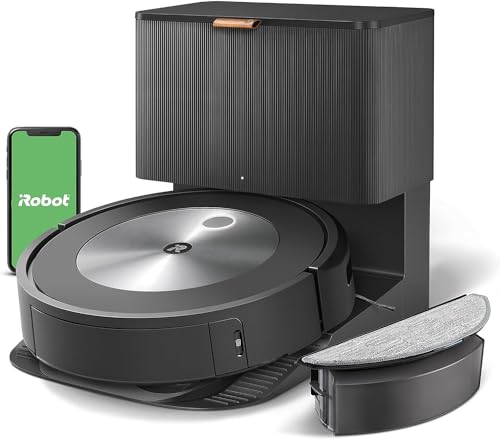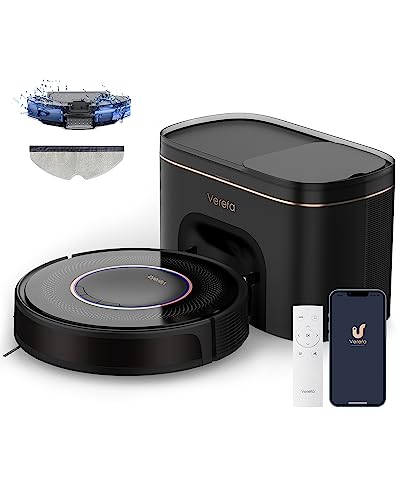10 Things That Your Family Taught You About Self Emptying Robot Vacuums
Self Emptying Robot Vacuums (Www.Robotvacuummops.Com)
Robot vacuums that self-empty let you to clean without touching anything. They don’t require you touch or empty their dustbin, which is a huge plus for people who have allergies.
Instead, it will dump its contents in a larger base which can store dirt for 45 to 60 days. Then, it will empty itself and return back to its dock.
Runtime boosted
Most robot vacuums come with an onboard dustbin that needs to be emptied at the end of each cleaning cycle. Adding an auto-emptying feature allows owners to enjoy a hands-free, stress-free experience. Although this feature is only available on some entry-level models this is an important feature that is offered to many premier robot vacuums.
 Self-emptying robots can be a real time saver for busy homeowners. For those who have to manage children and work, as well as chores, they don’t want the hassle of stopping their robotic cleaners to empty its onboard dustbin. Self-emptying models offer users the benefit of having a tidy home without having to stop their robot cleaner.
Self-emptying robots can be a real time saver for busy homeowners. For those who have to manage children and work, as well as chores, they don’t want the hassle of stopping their robotic cleaners to empty its onboard dustbin. Self-emptying models offer users the benefit of having a tidy home without having to stop their robot cleaner.
Some models that self-empty can also mop in addition to their main functions. They will automatically empty their mopping tank and then refill it with fresh water to prepare for the next cleaning cycle. In addition, these robots will also clean and dry the pads. This will ensure that the device is ready for its next cleaning cycle and will prevent the build-up of grime inside Introducing the HONITURE Q6 SE Robot Cleaner robot.
The newest version of the Roomba robot is packed with impressive features that will help busy homeowners get their home cleaned with minimal effort. Its innovative Dirt Detection System can identify dirt accumulations and concentrate cleaning efforts on the area. This ensures that the entire floor is thoroughly cleaned. The bot can also be used to create virtual zones for keeping out of and schedule multiple clean-ups throughout the day.
The intelligent navigation and mapping capabilities of the iRobot Roomba j7+ are another impressive feature. The bot is capable of recognizing flooring materials, furniture and other obstacles to improve mopping and navigation efficiency. It can be programmed to clean at a particular time and the app map lets homeowners to personalize the device.
The Neato BotVac D8 is a good option for those who want to combine the benefits of a robotic vacuum and self empty robot vacuum mop-emptying mop. It can mop and vacuum and its onboard reservoir can hold up to 45 days of dirt and debris. It has an automatic dirt sensor, as well as a self emptying base.
Continuous operation
Robot vacuums are great for removing surface debris and dirt from hard floors, however they do not have the suction power of upright models or canister models. They are also often unable to remove dirt that has been accumulated in carpets and rugs as well as dust that is close to baseboards and thresholds. Even the best robots are susceptible to getting caught in socks, toys and cords. This renders them less efficient than manual cleaning.
You will need to empty your trash bin frequently in order to avoid having to empty it every time you use your robot. This can be a huge trouble. Luckily, the latest self-emptying robot vacuums come with an automatic docking station that clears and cleans the dust bin without you having to do anything.
This feature will significantly cut down your cleaning times and the amount of dust that you have to get rid of making it an eco-friendly and sustainable device. In addition, it can help you keep your home free of fine dust particles that are often a major source of allergy in households.
Most of the top-rated robot vacuums have a large dustbin that can store weeks of dirt until it needs to be emptied. You can set up a schedule to have the device automatically empty the dustbin at set intervals, allowing to have a relaxing and stress-free cleaning.
The most advanced models of self-emptying robot vacuums also have the ability to map, which allows them to plan out a room or entire house and store the floor plan for later use. This enables the robot to avoid repeat areas, while increasing efficiency and reducing wasted movements. The latest robovacs utilize camera-, gyro- radar- or laser (laser distance sensor or LDS) guided systems to create a map of your space.
The most well-known self-emptying robot vacuums are able to be combined with an app that lets you create no-go zones as well as schedule cleaning sessions. The app allows you to monitor and control cleaning results remotely. This is particularly useful when guests are coming over, as it can give you peace of mind knowing that your home is being cleaned.
Less downtime
The standard robot vacuums collect dirt in an internal dustbin, which they must empty every two cleaning cycles. The self-emptying base eliminates this step, enabling the appliance to run indefinitely between sessions without interruption or the necessity of returning to its charging dock for more power. This reduces the downtime between cleaning cycles and allows larger homes to complete wall-to-wall clean-up in one go.
Some models allow you to set up a cleaning routine and use voice assistants like Alexa or Google Assistant for control. You can create no-go zones and track the robot’s moves. You can also modify settings, such as suction power or the amount of water that is dispersed to floors. These features might be extra however they will aid you in getting the most from your robotic vacuum.
A self-emptying vacuum eliminates the need for the user to reach or empty the collection container. This is great for those suffering from allergies and who need to perform other tasks around the house. The base can house months or weeks of dirt and other debris. You will only need to empty the base every 30 to 60 days, the same amount of time you have to empty the bin with a regular vacuum.
While many people find self-emptying robot vacuums more convenient, this feature won’t be suitable for everyone. For those who can’t pay for the extra cost you can opt for a less expensive model that has an internal dustbin that is designed to manage weeks of dirt. You’ll only need to replace the disposal bag on a regular basis.
The best self-emptying robot vacuums will have an excellent capacity for holding dirt, continuous operation and the ability to alter settings like suction power. You should also consider a model that has an integrated camera that lets you see what’s happening on your floors. Find out if the machine is compatible with an app which allows you to set up cleaning schedules, program “no-go zones” as well as monitor the robot and adjust other settings. Examine the specifications and the performance of the devices to find the best self-emptying robot vacuums.
User interaction is less
It’s only natural for home robotic helpers can clean themselves as we get more used to using our smartphones to calculate pi in a billion different places, activate street lights via electricity and purchase items. A self-emptying robot vacuum takes the concept a step further by taking care of its own collection canisters between cleaning sessions.
They typically have dustbins that are small, often no more than 4 inches in height, so they do not have the space to house a roomy dust bin as you’d find on an upright Dyson. They are also generally bagless and require regular manual emptying since the full bin can get clogged with hairballs and other debris.
To avoid the inconvenience of emptying their trash bins manually, these cleaners transfer all the dust and dirt that accumulates in their onboard dust bin into a storage bag within the base of their docking station. Depending on the model, these bags are usually designed to stop dust leakage and reduce the spread of allergens.
In addition to being less of an inconvenience, this hands-free maintenance also allows for longer run times between emptying cycles since the robot does not have to return to its base and empty its collection canister in order to continue running. This reduces downtime and allows robots to cover a greater area of ground and thoroughly clean rooms in one session.
The simplified maintenance also provides more convenience for parents, busy homeowners or anyone else with a busy lifestyle. This means that you can run your automated cleaner without having to stop multiple times throughout the week to empty the collection canister – it will simply continue to run until it has to return to its base for emptying weeks later. The self-emptying robotic vacuums can be used with a variety of today’s smart home platforms. This allows owners to monitor and control their robot vacuums from anywhere in the world via their smartphone apps or voice assistance. This integration level allows for proactive maintenance, transparency, and the ability to modify the cleaning schedules and even designate certain rooms.